Van Gogh’s cottage paintings captured spaces where life and nature intertwined through organic design. Modern cat furniture faces the same challenge: creating functional pieces that don’t clash with carefully curated homes. The revelation?
Cottage-style principles actually work better for cat behavior than modern alternatives. Natural materials and asymmetrical designs align with feline instincts, creating furniture cats genuinely use rather than ignore. These twelve designs prove that what looks right for your garden-inspired aesthetic is functionally superior for your cat.
1. The Thatched Roof Haven: Seagrass & Sisal Hideaways
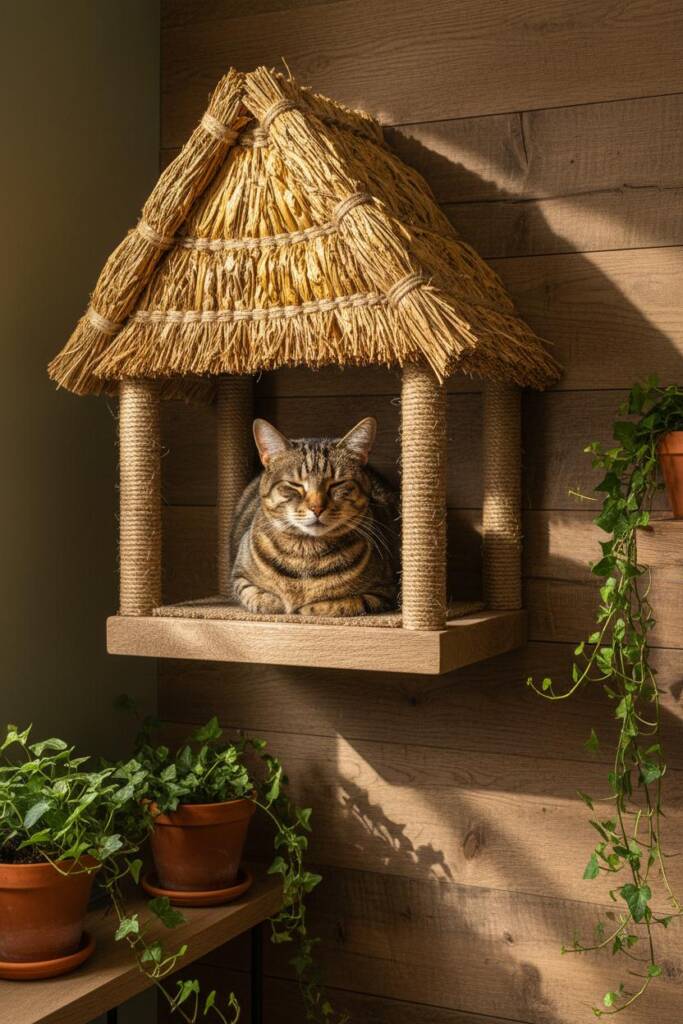
Seagrass and sisal canopies mimic the rough bark cats seek in tree canopies. Cats test structure stability with their claws before settling—synthetic carpet fails this instinct test, but natural fibers provide the tactile feedback they need.
These materials are humidity-resistant, perfect for sun-rooms with moisture-loving plants, and they age like garden baskets with attractive patina rather than looking worn. Choose hand-woven options with 3-4mm diameter fibers for durability. Position near windows overlooking your garden—the elevated vantage point satisfies territorial instincts while the textured surface handles post-nap scratching.
2. Weathered Wood Multi-Perch Towers with Asymmetrical Branches
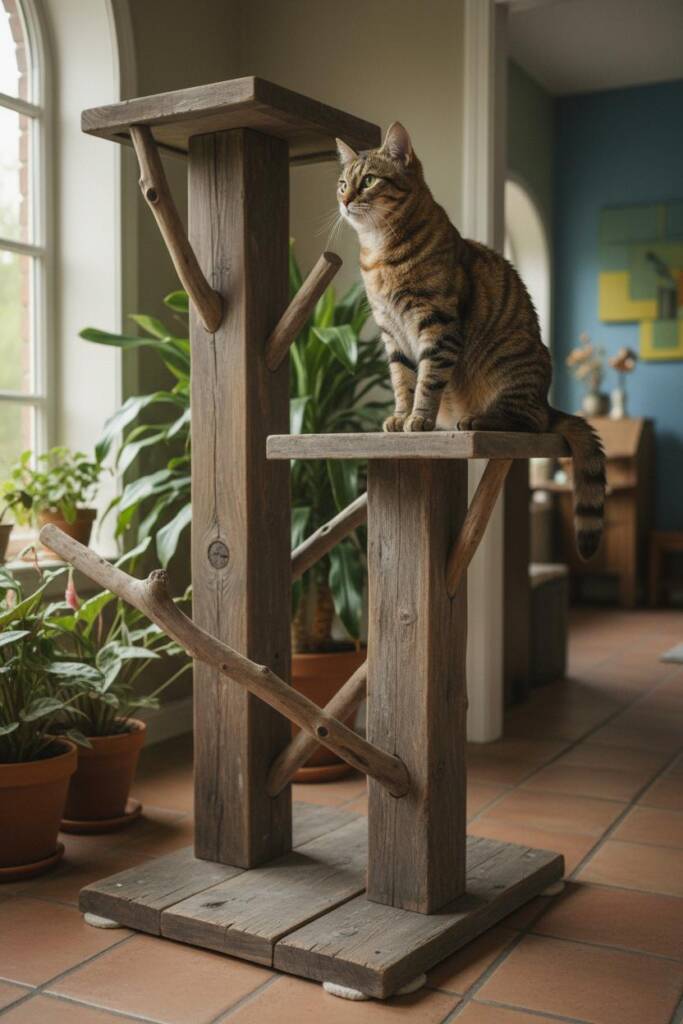
Cats navigate irregular branches in nature, developing proprioception through uneven surfaces. Asymmetrical perches at varying angles engage cats mentally and physically, while uniform towers bore them.
Natural wood grain, knots, and color variations provide superior claw grip, and authentic wood scent signals “safe natural environment” to cats’ olfactory systems. Reclaimed barn wood or driftwood requires no break-in period. Position near indoor plants—cats grooming on perches deter fungus gnats and plant pests from spreading.
3. Cottage Base with Climbing Vines (Integrated Planters)
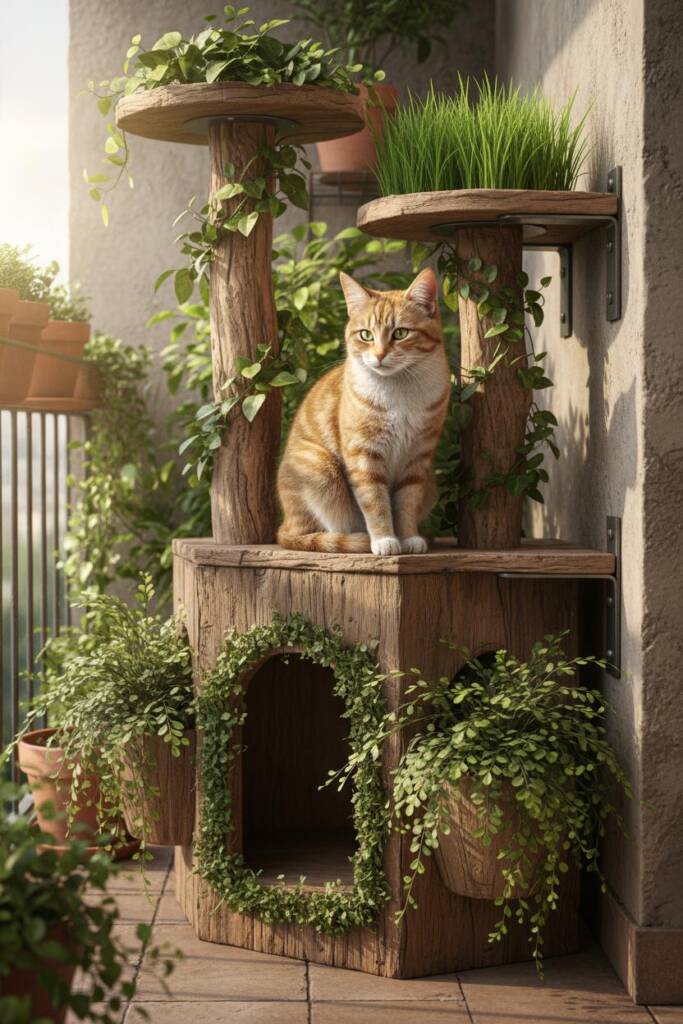
Cats are attracted to plants because greenery signals outdoor hunting environments. Integrated cat-safe planters (spider plants, Boston ferns, cat grass) satisfy this instinct in designated spaces, reducing interest in your other houseplants.
Faux stone bases provide thermal mass that stays naturally cool for overheating cats. Use self-watering planter inserts to prevent mess and choose plants with robust root systems. This creates a living sculpture that serves both plant care routine and cat enrichment. Position in bright indirect light where both plants and cats thrive.
4. Window Box Perch Extensions
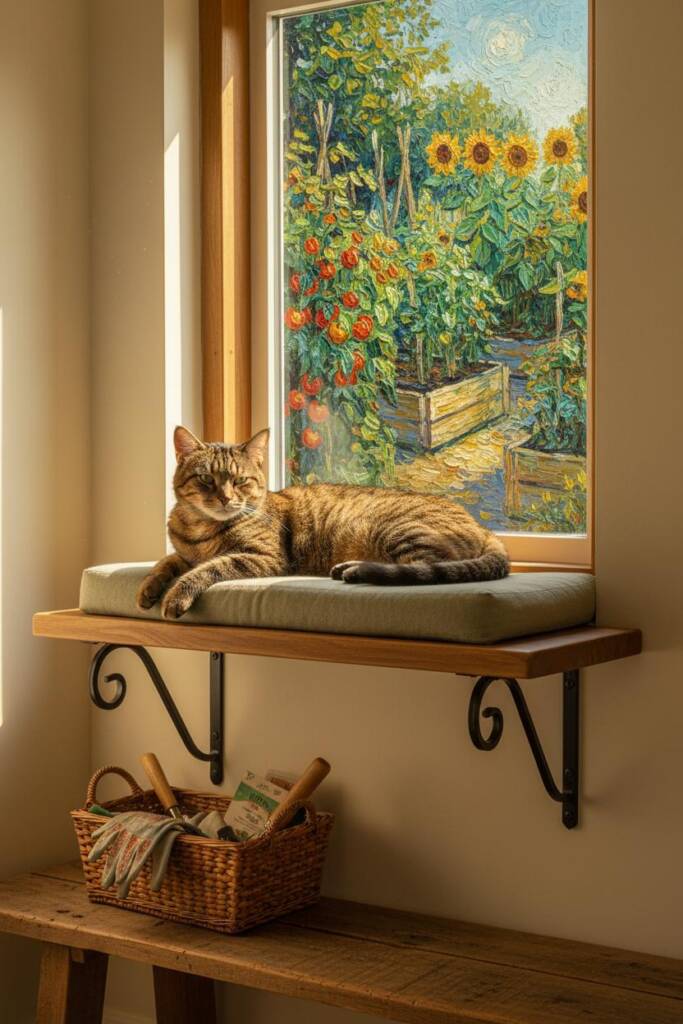
Window perches overlooking gardens transform cats into living pest deterrents. Birds, squirrels, and rabbits avoid areas with visible predators—a cat silhouette at garden bed level reduces bird damage to berries and squirrel bulb-digging without actual hunting. Perches need 14-inch depth for full lounging with slight lips preventing roll-off.
Natural wood or wicker platforms absorb heat gradually unlike metal that becomes uncomfortable in direct sun. Install on east or north-facing windows to avoid hot spots. Position window-mounted bird feeders 8-10 feet away—close enough for observation, far enough to prevent frustration. This provides enrichment while protecting garden investments.
5. Rustic Ladder & Platform System
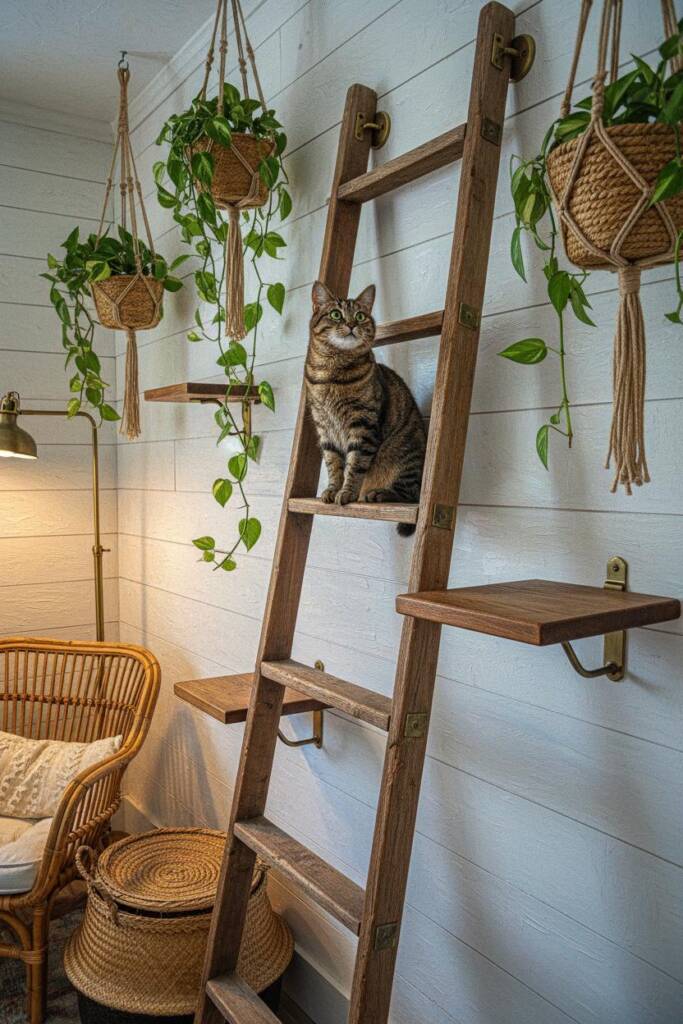
Ladder rungs force cats to make micro-decisions about paw placement with each step, providing mental stimulation that straight poles lack. This mimics vertical gardening principles—structures accommodating natural movement patterns rather than forcing rigid routes.
Vintage ladders (thoroughly sanded, no chemical treatments) can be repurposed with platform additions. Lean ladders at 70-degree angles for optimal climbing ergonomics. The repositionable design lets you adjust seasonally like garden trellises—angle toward winter sun or summer shade as needed. Platforms at irregular intervals (every 18-24 inches) create natural resting points without predictable patterns.
6. Cottage Chimney Hideout Towers
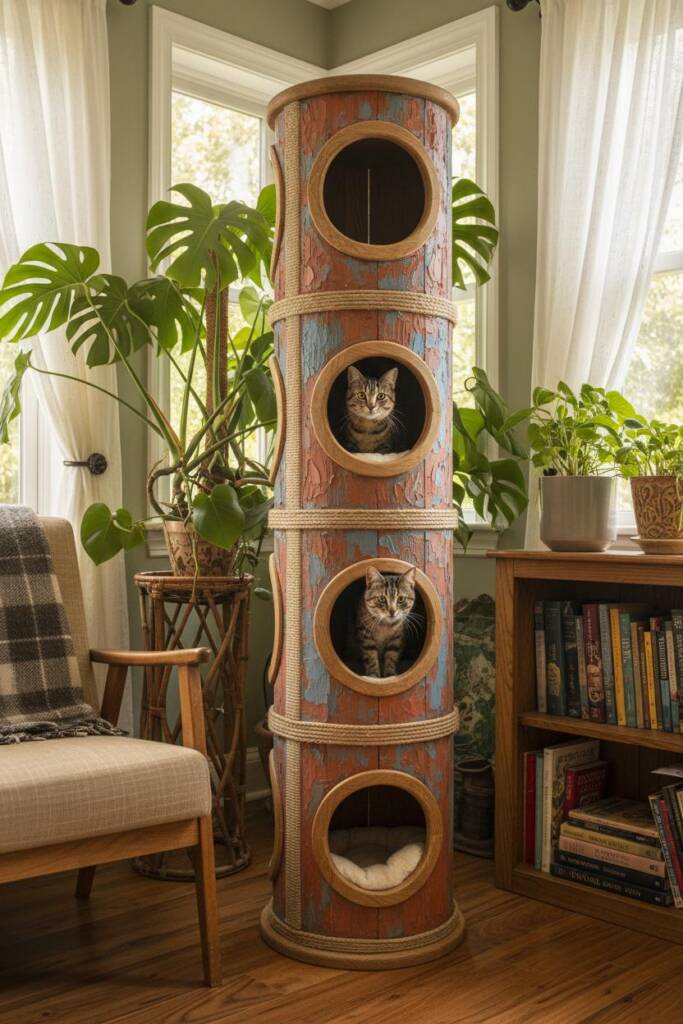
Vertical enclosed tubes mimic hollow tree trunks cats seek outdoors. In multi-cat homes, vertical hiding spots reduce territorial stress—cats naturally claim different “floors” like birds in trees, avoiding ground-level conflicts. These tall, narrow designs have small footprints (12-inch diameter), ideal for plant-filled rooms where floor space is premium.
Position between tall plant stands to create integrated vertical layers. Entry holes at different heights (lower, mid, upper) accommodate cats with varying mobility and confidence levels. Interior textures matter: leave wood unlined or use removable fleece for easy washing, avoiding permanently attached carpet that traps odors.
7. Woven Willow Basket Nesting Boxes
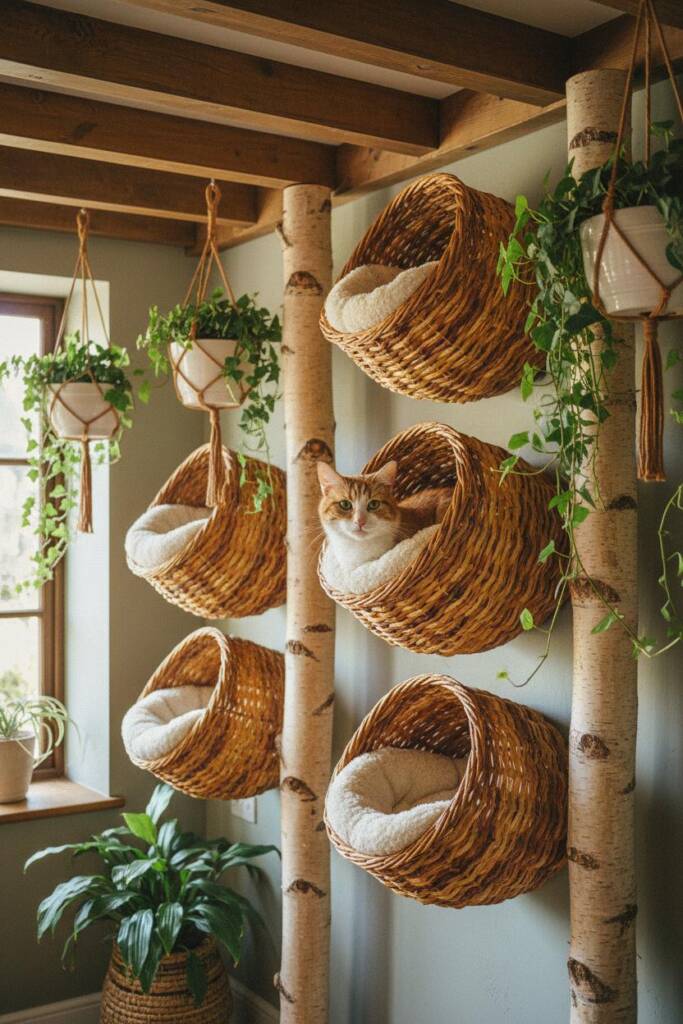
Willow basket pods mounted at various heights offer temperature regulation that synthetic materials cannot match. Natural fibers breathe—cooler in summer, insulating in winter—using the same principle as garden mulch regulating soil temperature. Cats sleep up to 16 hours daily, making temperature comfort critical for actual furniture use. Authentic willow (not plastic imitations) flexes slightly under weight, creating a cradling effect cats find secure.
These baskets are renewable and biodegradable, appealing to sustainable gardening values. Mount at different orientations—some facing walls for privacy-seekers, others facing outward for social cats. The woven texture catches and holds cat scent better than smooth surfaces, helping cats establish ownership quickly. Replace every 2-3 years as they naturally degrade, composting old baskets in your garden beds where the willow breaks down beneficially.
8. Countryside Bridge & Pathway Connectors
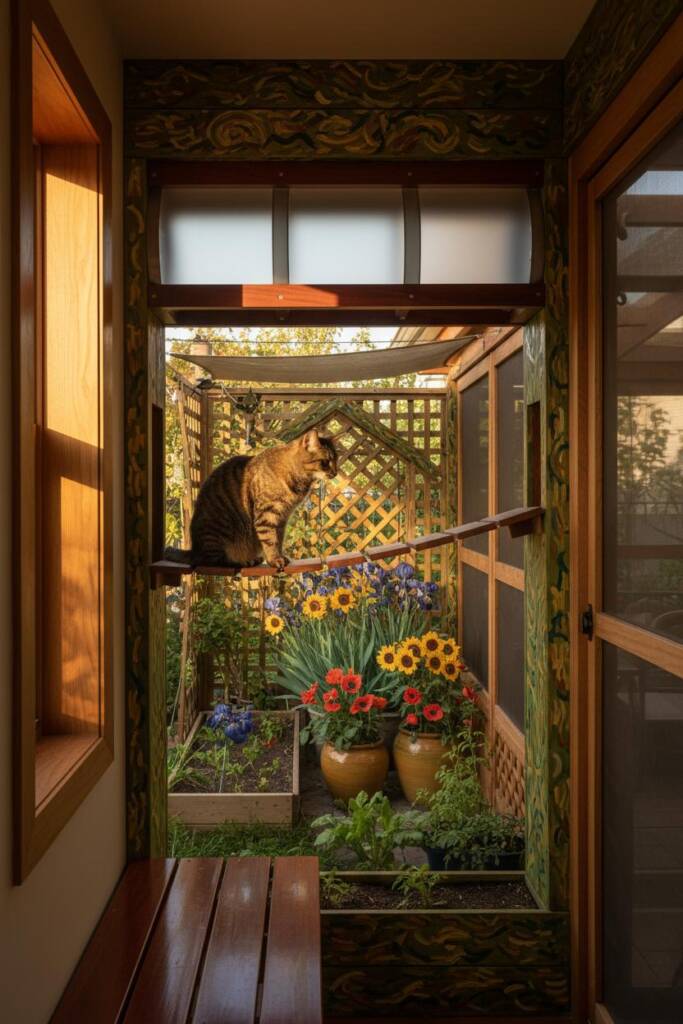
Arched bridges between tree sections create safe corridors that reduce cats’ vulnerability crossing open spaces. This mirrors stepping-stone logic in cottage gardens—defined paths encouraging movement through the space. Cats use entire structures more when they can move without exposed gaps. Bridges should be 8-10 inches wide with textured surfaces (sisal rope wrapping or carved wood grooves) preventing slips.
The arched design isn’t decorative—it provides headroom for confident walking rather than crouching, which cats associate with vulnerability. In smaller homes, bridges maximize vertical territory without increasing floor footprint. Connect bridges to wall-mounted elements, creating aerial pathways above your furniture and plants. This transforms unused ceiling space into cat highways while keeping floor areas open for your gardening supplies and plant displays.
9. Herb Garden Integrated Scratching Posts
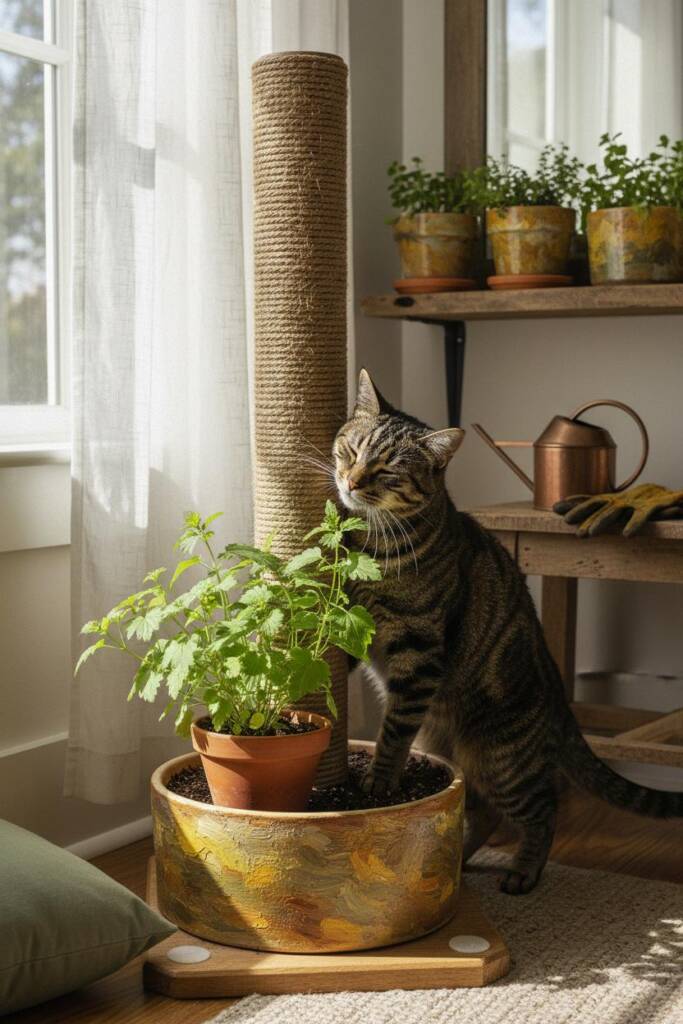
Growing fresh catnip, cat thyme, and valerian at scratching post bases gives you control over quality versus store-bought dried herbs that lose potency. Plant in removable pots with drainage, rotating seasonally like garden beds—spring catnip, summer cat thyme, fall valerian. Cats receive enrichment from both scent and texture simultaneously.
The planter rings (typically 6-8 inches deep) should sit at post bases where scratching vibrations won’t disturb roots. Use organic potting soil without fertilizers—cats will inevitably nibble. This setup costs less long-term than buying commercial cat treats, and herbs pruned during cat interaction can be dried for winter use.
Position posts near bright windows where herbs thrive, creating a functional focal point. The sisal wrapping above planters needs regular inspection—herb oils can accelerate wear, requiring replacement every 8-12 months versus 18-24 months for standard posts.
10. Distressed Painted Finishes with Floral Motifs
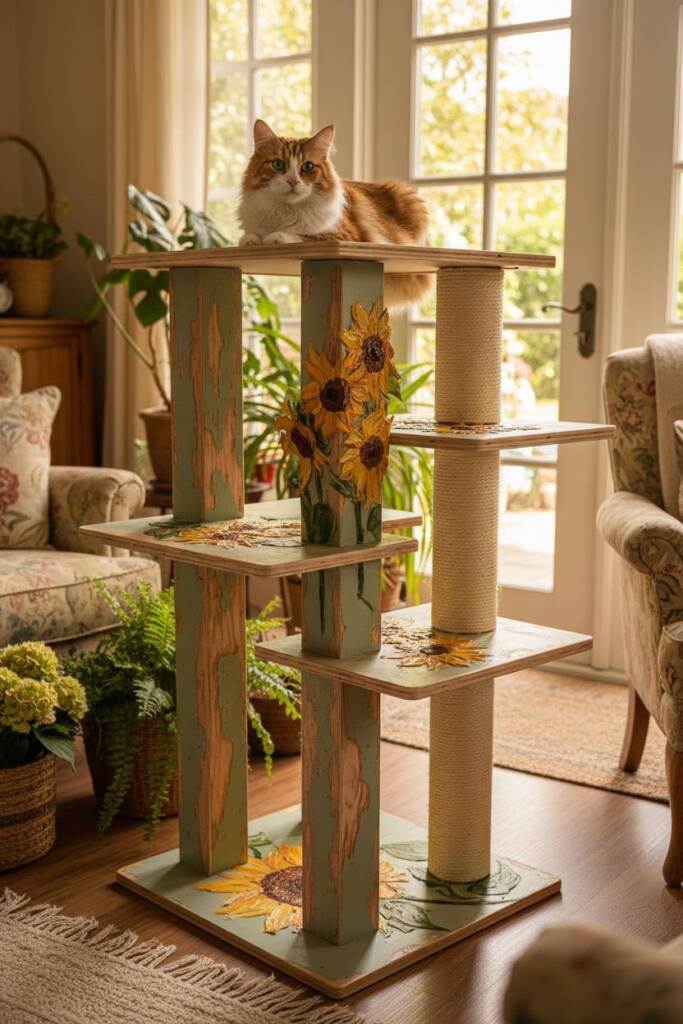
Hand-painted cottage florals transform cat furniture into display pieces you’ll position prominently rather than hide. The behavioral shift is significant: cats use furniture placed in social areas more because they want proximity to you, not exile in basements. Use non-toxic milk paint or chalk paint that buffs to soft finishes—no chemical off-gassing. Van Gogh’s sunflower or iris motifs work well on flat surfaces like platform bases.
This is DIY-friendly for updating existing furniture: sand lightly, apply two coats, distress edges with fine sandpaper for aged appearance. Seasonal refreshes are possible like rotating garden container colors—spring pastels, autumn earth tones. The painted surfaces need sealing with water-based polyurethane for durability against claws, but avoid high-gloss finishes that show every scratch. This approach rescues structurally sound but aesthetically dated cat trees, extending their life while matching evolving décor.
11. Rambling Rose Trellis-Style Wall-Mounted Systems
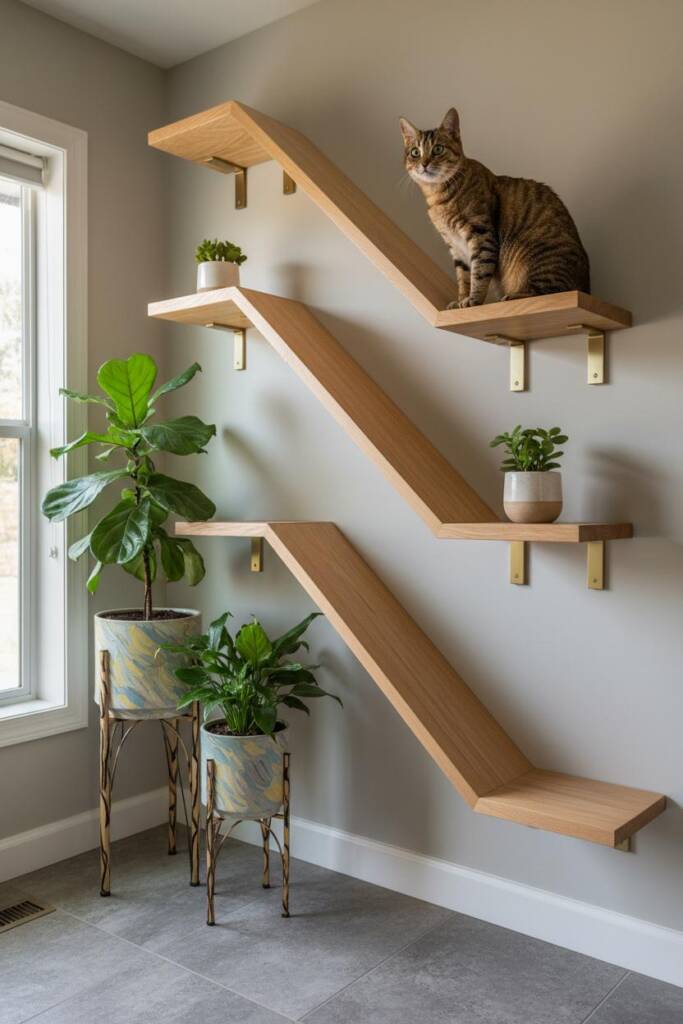
Wall-mounted vertical systems free floor space for actual plants, letting cats claim vertical territory without competing with your fiddle leaf fig’s footprint. This uses espalier principles—training growth along walls for maximum space efficiency. Mounting perches at 16-24 inch vertical intervals creates natural climbing rhythm.
The “rambling” aspect means perches stagger horizontally, not stacking directly—cats navigate diagonally, which feels more natural and provides better sightlines. Install near tall plant stands so cats can leap between furniture and flora, creating integrated climbing routes. Use heavy-duty brackets rated for 30+ pounds—cats launch onto perches with force, not gentle stepping.
The wall color matters: perches in contrasting tones (dark wood on light walls) help aging cats with declining vision navigate confidently. This design works especially well in narrow rooms where traditional floor trees would obstruct pathways between gardening stations and plant care areas.
12. Countryside Cottage Catio Connection Pieces
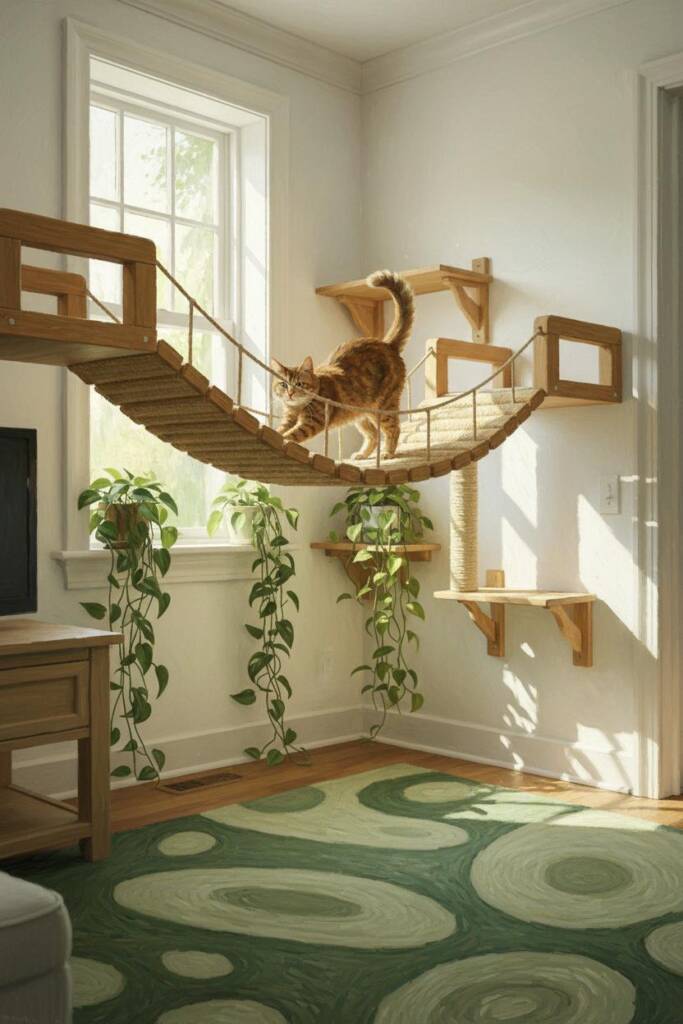
Transition furniture bridging indoor trees to outdoor catios or screened porches creates the ultimate gardener setup—cats supervising actual gardens safely. These pieces need weatherproof construction (cedar, treated pine, or composite materials) since they span environmental zones. The connection point requires cat doors or removable panels for seasonal access—summer outdoor freedom, winter indoor retreat with closed barrier.
Cats patrolling gardens deter deer, groundhogs, and rabbits more effectively than motion-activated sprinklers because predator presence is constant, not intermittent. Position indoor sections near doors with outdoor sections providing shade and elevation (4-6 feet up) for garden surveillance.
The visible cat presence near vegetable beds can reduce pest pressure by 40-60% according to gardeners using this setup. Include enclosed tunnels for the transition zone so cats feel secure moving between spaces. This investment pays dividends: reduced garden losses, increased cat enrichment, and year-round functional furniture rather than pieces used only seasonally.
Amazon Shopping List: Cottage-Style Cat Furniture Essentials
- Solid Wood Multi-Level Cat Tree (Unfinished/Rustic Pine) – Look for brands offering natural wood finish without carpet covering
- Wall-Mounted Floating Wood Cat Shelves Set – Asymmetrical placement pieces in walnut, pine, or weathered wood finishes
- Woven Wicker/Rattan Cat Bed Basket – Authentic willow or rattan construction, mountable or freestanding options
- Window-Mounted Cat Perch with Wooden Frame – Natural wood construction with cushioned platform, cottage-style brackets
Bringing Van Gogh’s Vision Home
Van Gogh understood cottages as living spaces harmonizing with their surroundings, not objects imposed upon them. Cottage-style cat furniture applies this wisdom—creating harmony between your gardening passion, home aesthetic, and pet’s behavioral needs.
Start with one piece matching your gardening aesthetic—even retrofitting existing furniture with natural materials or cat-safe plants transforms it from eyesore to intentional design element. Your cat benefits from behaviorally appropriate features, your garden benefits from feline pest deterrence, and your home becomes a cohesive sanctuary where all elements support each other.
For more inspiration on blending beautiful home design with pet-friendly living, Sweet Purrfections is your go-to resource for pet parents who refuse to compromise on style.
Meet Sean, a fintech whiz with a penchant for pet purrs and blockchain buzz. After a decade of fintech feats, Sean’s tech talents leaped from ledger lines to litter lines, driven by a passion for pets and a vision for a more connected pet care community. With three critter companions as co-pilots, Sean launched this blog to share a treasury of pet-friendly tech tips and tales.


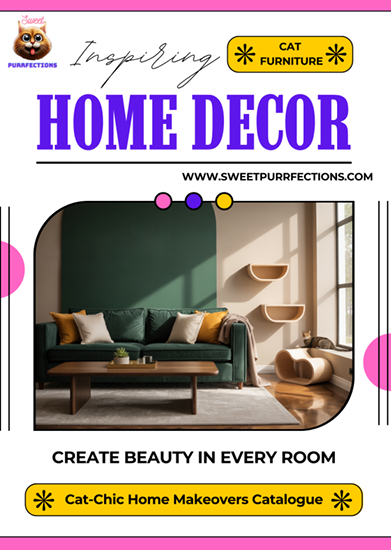
Leave a Reply